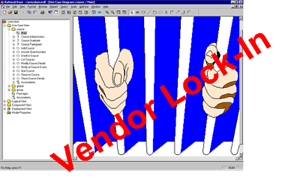 |
|
| |
|








|
The idea of EVE
Today models are a format for tools
and basic services. They could not be exchanged  between
different tools and therefore clients were tied to a specific vendor.
As a result models are not reusable and services for the same application
domain have to be reinvented in a costly and time-consuming way for
different tools. Thus, the community could not reach a critical mass. between
different tools and therefore clients were tied to a specific vendor.
As a result models are not reusable and services for the same application
domain have to be reinvented in a costly and time-consuming way for
different tools. Thus, the community could not reach a critical mass.
The appearance of XML and the subsequent definition
of the eXtensible Metainformation Interchange standard (XMI)
opened a way do deal with the problem of different storage formats.
The tool market shows a small but ever increasing number of tools
capable of working with XMI. EVE provides efficient
export and import plugs to enforce this development.
Another problem of today's modeling tools is the lack of basic functionalities
like constraint monitoring to discover design errors early during
modeling, model evolution because in object-oriented modeling, methods
often encompass dependency rules, which describe modification steps
and usually the existence of certain parts of the model in an earlier
phase implies the existence of dependent parts in later phase or code
synchronization within models can be kept synchronized with code through
roundtrip engineering.
The future are modeling tools as services
and thin clients. Fault tolerant and light-weight distribution platforms
provide the deployment of services in arbitrary locations. Standardized
storage formats provide a basis of model exchange and allow processing
of models created by arbitrary tools. Ubiquitous browser technology
and open graphics standards allow universal presentation. But to use
models as effective input for a domain process, closely-fitting domain
constrains and documentation must be formulated. This needs a mechanism
which allows modelers to 'factor out' domain knowledge to communicate
it seperately and to 'factor in'domain knowledge to apply it effeciently.
EVE supports a modelling community to collaborate,
to promote good modeling methods and services into industrial practice
and to gather feedback for the research community with following features:
Model Services
Services are moved out of fat-client tool and embedded in a sharing
mechanism, so the whole community can benefit from a local development.
Model Viewers
Models and service feedback can be displayed in a brwoser, so the
peruse of model and process data increases.
Domain-level Reuse
Profiles can be added to a model and act like a construction template.
They at once introduce to the model the constructs and constrains
of the domain in a form which people can understand and service can
evaluate.
|
|

